Black & Decker CS1030L User Manual
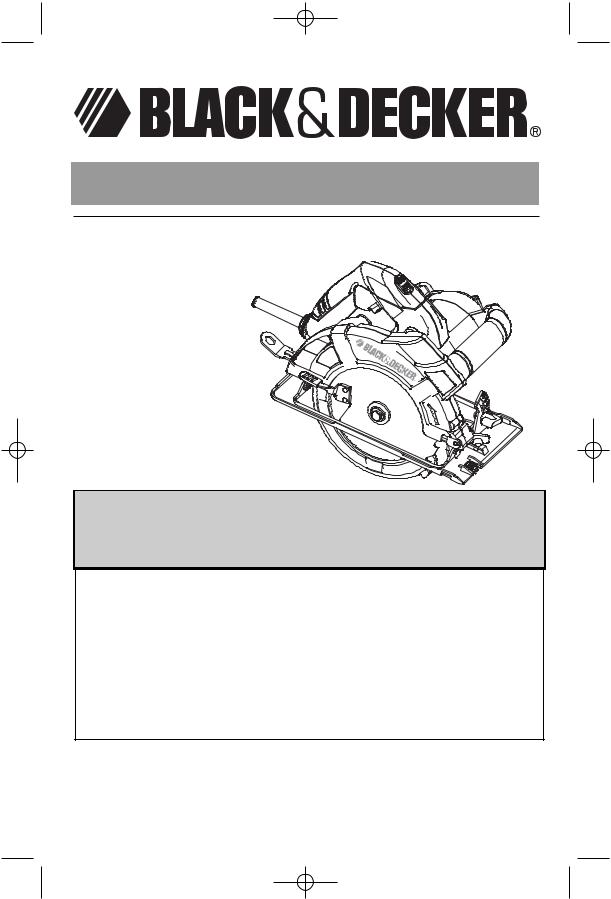
642743-00 CS1030 CS1040L 4/13/06 10:06 AM Page 1
7-1/4” (185mm) Circular Saws
INSTRUCTION MANUAL
Catalog Numbers
CS1030L / CS1040L
THANK YOU FOR CHOOSING BLACK & DECKER!
GO TO WWW.BLACKANDDECKER.COM/NEWOWNER
TO REGISTER YOUR NEW PRODUCT.
BEFORE RETURNING THIS PRODUCT FOR ANY REASON PLEASE CALL
1-800-544-6986
BEFOREYOUCALL,HAVETHECATALOGNo.ANDDATECODEAVAILABLE.INMOSTCASES,A
BLACK&DECKERREPRESENTATIVECANRESOLVETHEPROBLEMOVERTHEPHONE.IFYOUHAVEA SUGGESTIONORCOMMENT,GIVEUSACALL.YOURFEEDBACKISVITALTOBLACK&DECKER.
SAVE THIS MANUAL FOR FUTURE REFERENCE.
VEA EL ESPAÑOL EN LA CONTRAPORTADA.
INSTRUCTIVO DE OPERACIÓN, CENTROS DE SERVICIO
Y PÓLIZA DE GARANTÍA. ADVERTENCIA: LÉASE ESTE
INSTRUCTIVO ANTES DE USAR EL PRODUCTO.
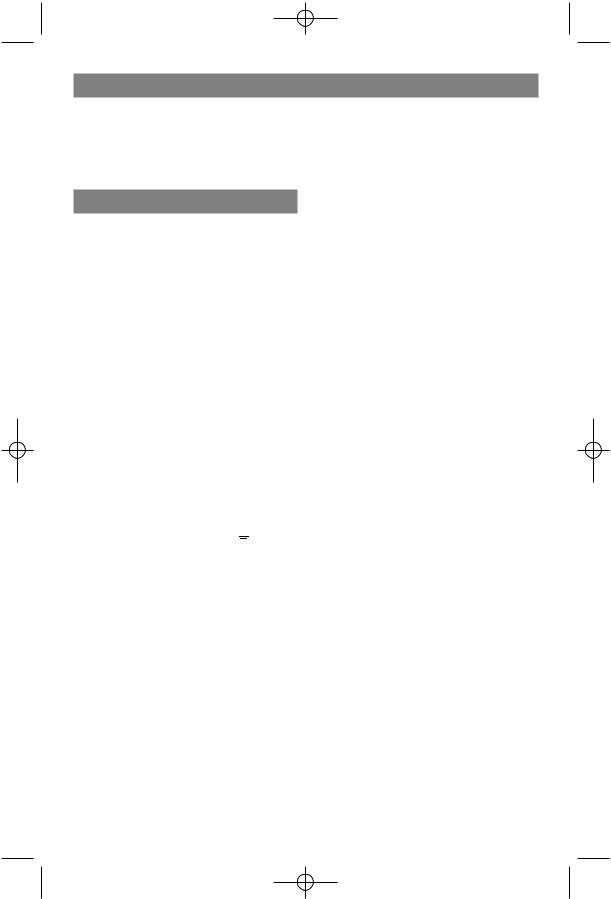
642743-00 CS1030 CS1040L 4/13/06 10:06 AM Page 2
GENERAL SAFETY RULES
 WARNING: Read and understand all instructions. Failure to follow all instructions listed below, may result in electric shock, fire and/or serious personal injury.
WARNING: Read and understand all instructions. Failure to follow all instructions listed below, may result in electric shock, fire and/or serious personal injury.
SAVE THESE INSTRUCTIONS
Work Area
•Keep your work area clean and well lit. Cluttered benches and dark areas invite accidents.
•Do not operate power tools in explosive atmospheres, such as in the presence of flammable liquids, gases, or dust. Power tools create sparks which may ignite the dust or fumes.
•Keep bystanders, children, and visitors away while operating a power tool. Distractions can cause you to lose control.
Electrical Safety
•Double insulated tools are equipped with a polarized plug (one blade is wider than the other.) This plug will fit in a polarized outlet only one way. If the plug does not fit fully in the outlet, reverse the plug. If it still does not fit, contact a qualified electrician to install a polarized
outlet. Do not change the plug in any way. Double insulation 


 eliminates the need for the three wire grounded power cord and grounded power supply system.
eliminates the need for the three wire grounded power cord and grounded power supply system.
•Avoid body contact with grounded surfaces such as pipes, radiators, ranges and refrigerators. There is an increased risk of electric shock if your body is grounded.
•Don’t expose power tools to rain or wet conditions. Water entering a power tool will increase the risk of electric shock.
•Do not abuse the cord. Never use the cord to carry the tools or pull the plug from an outlet. Keep cord away from heat, oil, sharp edges or moving parts. Replace damaged cords immediately. Damaged cords increase the risk of electric shock.
•When operating a power tool
outside, use an outdoor extension cord marked “W-A” or “W.” These cords are rated for outdoor use and reduce the risk of electric shock.
Minimum Gage for Cord Sets
Volts |
|
Total Length of Cord in Feet |
|
||
120V |
|
0-25 |
26-50 |
51-100 |
101-150 |
240V |
|
0-50 |
51-100 |
101-200 |
201-300 |
Ampere Rating |
AWG |
|
|
||
More |
Not more |
|
|
||
Than |
Than |
|
|
|
|
|
|
|
|
|
|
0 - |
6 |
18 |
16 |
16 |
14 |
6 - |
10 |
18 |
16 |
14 |
12 |
10- |
12 |
16 |
16 |
14 |
12 |
12- |
16 |
14 |
12 |
Not Recommended |
|
Personal Safety
•Stay alert, watch what you are doing and use common sense when operating a power tool. Do not use tool while tired or under the influence of drugs, alcohol, or medication. A moment of inattention while operating power tools may result in serious personal injury,
•Dress properly. Do not wear loose clothing or jewelry. Contain long hair. Keep your hair, clothing, and gloves away from moving parts.
Loose clothes, jewelry, or long hair can be caught in moving parts. Air vents cover moving parts and should be avoided.
•Avoid accidental starting. Be sure switch is off before plugging in.
Carrying tools with your finger on the switch or plugging in tools that have the switch on invites accidents.
•Remove adjusting keys or wrenches before turning the tool on. A wrench or a key that is left attached to a rotating part of the tool may result in personal injury.
•Do not overreach. Keep proper footing and balance at all times.
Proper footing and balance enables better control of the tool in unexpected situations.
•Use safety equipment. Always wear eye protection. Dust mask, non-skid safety shoes, hard hat, or hearing protection must be used for appropriate conditions.
Tool Use and Care
•Use clamps or other practical way to secure and support the workpiece
2
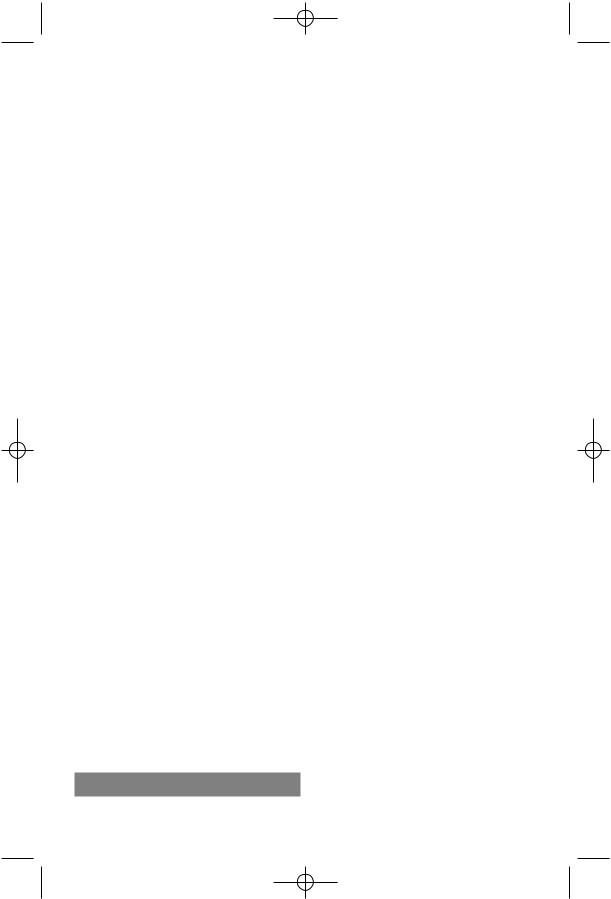
642743-00 CS1030 CS1040L 4/13/06 10:06 AM Page 3
to a stable platform. Holding the work by hand or against your body is unstable and may lead to loss of control.
•Do not force tool. Use the correct tool for your application. The correct tool will do the job better and safer at the rate for which it is designed.
•Do not use tool if switch does not turn it on or off. Any tool that cannot be controlled with the switch is dangerous and must be repaired.
•Disconnect the plug from the power source before making any adjustments, changing accessories, or storing the tool. Such preventative safety measures reduce the risk of starting the tool accidentally.
•Store idle tools out of reach of children and other untrained persons. Tools are dangerous in the hands of untrained users.
•Maintain tools with care. Keep cutting tools sharp and clean.
Properly maintained tools, with sharp cutting edges are less likely to bind and are easier to control.
•Check for misalignment or binding of moving parts, breakage of parts, and any other condition that may affect the tools operation. If damaged, have the tool serviced before using. Many accidents are caused by poorly maintained tools.
•Use only accessories that are recommended by the manufacturer for your model. Accessories that may be suitable for one tool, may become hazardous when used on another tool.
Service
•Tool service must be performed only by qualified repair personnel. Service or maintenance performed by unqualified personnel could result in a risk of injury.
•When servicing a tool, use only identical replacement parts. Follow instructions in the Maintenance section of this manual. Use of unauthorized parts or failure to follow Maintenance Instructions may create a risk of electric shock or injury.
SPECIFIC SAFETY RULES
 DANGER! Keep hands away from cutting area and blade. Keep your
DANGER! Keep hands away from cutting area and blade. Keep your
second hand on auxiliary handle, or motor housing. If both hands are holding the saw, they cannot be cut by the blade.
•Keep your body positioned to either side of the saw blade, but not in line with the saw blade. KICKBACK could case the saw to jump backwards. (See “Causes and Operator Prevention of Kickback.”)
•Do not reach underneath the work.
The guard can not protect you from the blade below the work.
•Check lower guard for proper closing before each use. Do not operate saw if lower guard does not move freely and close instantly. Never clamp or tie the lower guard into the open position. If saw is accidentally dropped, the lower guard may be bent. Raise the lower guard with the Retracting Lever and make sure it moves freely and does not touch the blade or any other part, at all angles and depth of cut.
•Check the operation and condition of the lower guard spring. If the guard and the spring are not operating properly, they must be serviced before use. Lower guard may operate sluggishly due to damaged parts, gummy deposits, or a buildup of debris.
•Lower guard should be retracted manually only for special cuts such as “Pocket Cuts” and “Compound Cuts.” Raise lower guard by Retracting Lever. As soon as blade enters the material, lower guard must be released. For all other sawing, the lower guard should operate automatically.
•Always observe that the lower guard is covering the blade before placing saw down on bench or floor. An unprotected, coasting blade will cause the saw to walk backwards, cutting whatever is in its path. Be aware of the time it takes for the blade to stop after switch is released.
•NEVER hold piece being cut in your hands or across your leg. It is important to support the work properly to minimize body exposure, blade binding, or loss of control.
•Hold tool by insulated gripping surfaces when performing an operation where the cutting tool may
3
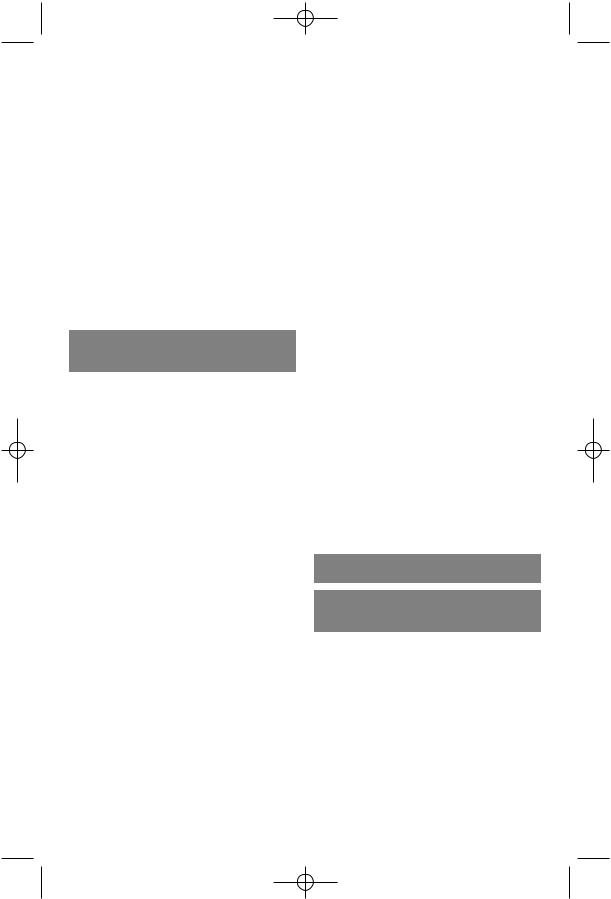
642743-00 CS1030 CS1040L 4/13/06 10:06 AM Page 4
contact hidden wiring or its own cord. Contact with a “live” wire will also make exposed metal parts of the tool “live” and shock the operator.
•When ripping, always use a rip fence or straight edge guide. This improves the accuracy of cut and reduces the chance for blade binding.
•Always use blades with correct size and shape (diamond vs. round) arbor holes. Blades that do not match the mounting hardware of the saw will run eccentrically, causing loss of control.
•Never use damaged or incorrect blade washers or bolts. The blade washers and bolt were specially designed for your saw, for optimum performance and safety of operation.
CAUSES AND OPERATOR PREVENTION OF KICKBACK:
•Kickback is a sudden reaction to a pinched, bound or misaligned saw blade, causing an uncontrolled saw to lift up and out of the workpiece toward the operator.
•When the blade is pinched or bound tightly by the kerf closing down, the blade stalls and the motor reaction drives the unit rapidly back toward the operator.
•If the blade becomes twisted or misaligned in the cut, the teeth at the back edge of the blade can dig into the top surface of the wood causing the blade to climb out of the kerf and jump back toward operator.
•Kickback is the result of tool misuse and/or incorrect operating procedures or conditions and can be avoided by taking proper precautions as given below.
a.Maintain a firm grip with both hands on the saw and position your body and arm to allow you to resist KICKBACK forces. Kickback forces can be controlled by the operator, if proper precautions are taken.
b.When blade is binding, or when interrupting a cut for any reason, release the trigger and hold the saw motionless in the material until the blade comes to a
complete stop. Never attempt to remove the saw from the work or pull the saw backward while the blade is in motion or KICKBACK may occur. Investigate and take corrective actions to eliminate the cause of blade binding.
c.When restarting a saw in the workpiece, center the saw blade in the kerf and check that the saw teeth are not engaged into the material. If saw blade is binding, it may walk up or KICKBACK from the workpiece as the saw is restarted.
d.Support large panels to minimize the risk of blade pinching and KICKBACK. Large panels tend to sag under their own weight. Support must be placed under the panel on both sides, near the line of cut and near the edge of the panel.
e.Do not use dull or damaged blade. Unsharpened or improperly set blades produce narrow kerf causing excessive friction, blade binding, and KICKBACK.
f.Blade depth and bevel adjusting locking levers must be tight and secure before making cut. If blade adjustment shifts while cutting, it may cause binding and KICKBACK.
g.Use extra caution when making a “Pocket Cut” into existing walls or other blind areas. The protruding blade may cut objects that can cause KICKBACK.
SAVE THESE INSTRUCTIONS
SE THESE INSTRUCTIONS ADDITIONAL SAFETY RULES:
CIRCULAR SAWS
 WARNING: Some dust created by power sanding, sawing, grinding, drilling, and other construction activities contains chemicals known to cause cancer, birth defects or other reproductive harm. Some examples of these chemicals are:
WARNING: Some dust created by power sanding, sawing, grinding, drilling, and other construction activities contains chemicals known to cause cancer, birth defects or other reproductive harm. Some examples of these chemicals are:
•lead from lead-based paints,
•crystalline silica from bricks and cement and other masonry products,
•arsenic and chromium from chemically-treated lumber (CCA).
Your risk from these exposures varies, depending on how often you do this type
4
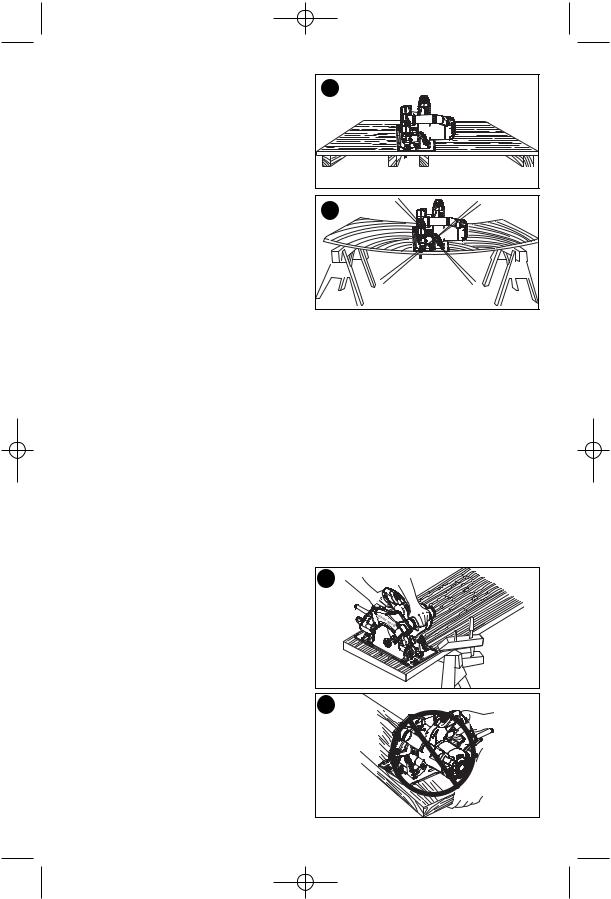
642743-00 CS1030 CS1040L 4/13/06 10:06 AM Page 5
of work. To reduce your exposure to these chemicals: work in a well ventilated area, and work with approved safety equipment, such as those dust masks that are specially designed to filter out microscopic particles.
•Avoid prolonged contact with dust from power sanding, sawing, grinding, drilling, and other construction activities. Wear protective clothing and wash exposed areas with soap and water.
Allowing dust to get into your mouth, eyes, or lay on the skin may promote absorption of harmful chemicals.
 WARNING: Use of this tool can generate and/or disburse dust, which may cause serious and permanent respiratory or other injury. Always use NIOSH/OSHA approved respiratory protection appropriate for the dust exposure. Direct particles away from face and body.
WARNING: Use of this tool can generate and/or disburse dust, which may cause serious and permanent respiratory or other injury. Always use NIOSH/OSHA approved respiratory protection appropriate for the dust exposure. Direct particles away from face and body.
 CAUTION: Wear appropriate hearing protection during use. Under some conditions and duration of use, noise from this product may contribute to hearing loss.
CAUTION: Wear appropriate hearing protection during use. Under some conditions and duration of use, noise from this product may contribute to hearing loss.
•Snagging the lower guard on a surface below the material being cut can momentarily reduce operator control. The saw can lift partially out of the cut increasing the chance of blade twist. Ensure there is sufficient clearance under the workpiece.
•When necessary to raise lower guard manually, use the retracting lever.
•KEEP THE BLADES CLEAN AND SHARP. Sharp blades minimize stalling and kickback. The use of dull and/or dirty blades can increase the saw loading causing the operator to push harder which promotes twisting.
 DANGER: LACERATION HAZARD. KEEP HANDS AWAY FROM CUTTING AREA. Keep hands away from blades. Never place hands in front of or behind the path of the blade while cutting. Do not reach underneath work while blade is rotating. Do not attempt to remove cut material when blade is moving.
DANGER: LACERATION HAZARD. KEEP HANDS AWAY FROM CUTTING AREA. Keep hands away from blades. Never place hands in front of or behind the path of the blade while cutting. Do not reach underneath work while blade is rotating. Do not attempt to remove cut material when blade is moving.
•SUPPORT LARGE PANELS. Large panels must be supported as shown (figure 1) in this manual to minimize the risk of blade pinching and kickback. Material supported only at the ends (figure 2) will lead to blade pinching. When cutting operation requires the resting of the saw on the workpiece, the saw shall be rested on the larger portion and the smaller piece cut off.
1 |
2 |
ONLY CORRECT BLADES AND ASSEMBLY COMPONENTS MOUNTING BLADES. Do not
blades with incorrect size holes. use defective or incorrect blade
or bolts. Follow blade assembly
.
. Before cutting be sure and bevel adjustments are tight.
AND SECURE THE WORK
. Insure that the material to cut is clamped (figure 3) and solidly
and balanced on a strong, and level work surface. Support work so that the wide portion of the
shoe is on the portion of the
that doesn’t fall after the cut is
.Never hold cut off piece by hand 4 ). KICKBACK from blade pinch
result. Keep both hands on saw at times.
3 |
4 |
5
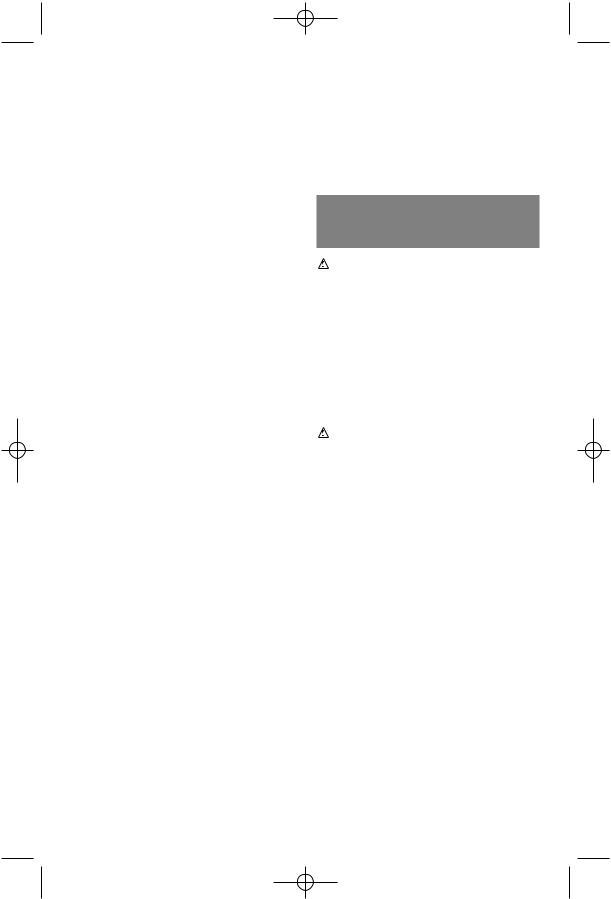
642743-00 CS1030 CS1040L 4/13/06 10:06 AM Page 6
•STAY ALERT AND EXERCISE CONTROL. Keep body positioned to one side of blade. Always maintain a firm grip and control of saw with both hands. Do not change hand grip or body position while saw is running. Take precaution to avoid injury from cut off pieces and other falling material during operation.
 DANGER: RELEASE SWITCH IMMEDIATELY IF BLADE BINDS OR SAW STALLS
DANGER: RELEASE SWITCH IMMEDIATELY IF BLADE BINDS OR SAW STALLS
GUARD AGAINST KICKBACK
•KICKBACK CAN BE CAUSED BY the saw blade becoming pinched, twisted or bound while cutting, or when the saw stalls. When the blade becomes twisted or misaligned in the cut, the teeth at the back edge of the blade can dig into the top surface of the wood causing the blade to climb out of the cut and move suddenly back toward the operator.
TO REDUCE THE RISK OF KICKBACK
•Keep a firm grip on saw with both hands at all times.
•Stay alert – exercise control.
•Support long overhanging materials. As the material is cut and weakens, it will sag, causing a pinched blade.
•Support large panels as shown (Fig. 1). Material supported only at the ends (Fig. 2) will lead to blade pinching.
•Avoid sawing overhead. Material can sag and will pinch blade.
•Keep blades sharp and clean.
•Use fence or straight edge guide when ripping. Be careful as the cut off strip can sag or twist, closing the cut and pinching the blade, leading to KICKBACK.
•Don’t force tool. Wood variables such as knots, hardness, toughness, wetness, pressure treated and freshly cut green lumber can heavily load the saw which can lead to stalling. Push the saw slower when this occurs.
•Don’t remove saw from work during a cut while the blade is moving.
•Allow saw to reach full speed before blade contacts material to be cut. Starting the saw with the blade against the work or pushed forward into cut can lead to stalling or sudden backward movement of saw.
•Never attempt to lift saw when making a bevel cut. This leads to blade binding and stalling.
•Always secure work to prevent workpiece movement during cut.
•Do not try to force saw back on line if your cut begins to go off line. This can cause KICKBACK. Stop saw and allow blade to coast down to a stop. Withdraw from cut and start a new cut on the line.
•Set depth adjustment of saw such that
one tooth of the blade projects below the workpiece as shown in (figure 8).
•Do not back up a rotating blade in the cut. Twisting the saw can cause the back edge of the blade to dig into the material, climb out of the work and run back toward the operator.
•Avoid cutting nails. Inspect for and remove all nails from lumber before cutting.
SAFETY INSTRUCTIONS -
LASERS
DANGER: Laser radiation, avoid direct eye exposure, serious eye injury can result.
•Do not use optical tools such as a telescope or transit to view the laser beam.
•Position the laser so unintentional eye contact will be avoided.
•Do not operate the laser around children or allow children to operate the laser.
•Do not disassemble. Modifying the product in any way can increase the risk of laser radiation.
WARNING: Use of controls or adjustments or performance of procedures other than those specified in this manual may result in hazardous laser radiation exposure.
•Do not operate in explosive atmospheres, such as in the presence of flammable liquids, gases, or dust.
•Store idle product out of reach of children and other untrained persons. Lasers / power tools are dangerous in the hands of untrained users.
•Use only accessories that are recommended by the manufacturer for your model. Accessories that may be suitable for one laser / power tool, may create a risk of injury when used on another laser / power tool.
•Repairs and servicing MUST be performed by a qualified repair facility. Repairs performed by unqualified personnel could result in serious injury.
•Do not remove or deface warning labels. Removing labels increases the risk of exposure to radiation.
•For indoor use only.
•This product is intended for use in a temperature range of 41°F(5°C) - 104°F(40°C).
NOTE: Laser is set at the factory and is not adjustable.
 CAUTION: Use of controls or adjustments or performance of
CAUTION: Use of controls or adjustments or performance of
6

642743-00 CS1030 CS1040L 4/13/06 10:06 AM Page 7
procedures other than those specified in this manual may result in hazardous laser radiation exposure.
The following laser warnings are located on your saw.
5 DANGER
LASER RADIATION. AVOID DIRECT EYE EXPOSURE.
MAXIMUM OUTPUT POWER< 5mW@633nm670nm CLASS IIIa LASER PRODUCT. THIS
PRODUCT COMPLIES WITH THE APPLICABLE REQUIREMENTS OF 21CFR PARTS 1040.10 AND
1040.11.
Avoid exposure. Laser radiation is emitted from these apertures.
Evite la exposición. A través de estas aperturas se emite radiación láser.
The label on your tool may include the following symbols.
V.............. |
volts |
|||
mW.......... |
milliwatts |
|||
nm .......... |
wavelength in nonometers |
|||
IIIa .......... |
Class IIIA Laser |
|||
A.............. |
amperes |
|||
Hz............ |
hertz |
|||
W ............ |
watts |
|||
min .......... |
minutes |
|||
|
|
............ |
|
alternating current |
|
|
|
|
direct current |
|
|
|
........ |
|
no ............ |
no load speed |
|||
|
|
............ |
|
Class II Construction |
…/min...... |
revolutions or |
|||
|
|
|
|
reciprocation per minute |
|
|
|
|
earthing terminal |
|
|
|
|
|
|
|
............ |
|
|
|
|
|
|
|
|
|
............ |
|
safety alert symbol |
MOTOR
Be sure your power supply agrees with nameplate marking. 120 Volts AC means your tool will operate on standard 60 Hz household power. Do not operate AC tools on DC. A rating of 120 volts AC/DC means that your tool will operate on standard 60 Hz AC or DC power. This information is printed on the nameplate.
Lower voltage will cause loss of power and can result in over-heating. All Black & Decker tools are factory-tested; if this tool does not operate, check the power supply. This tool is AC only.
OVERVIEW (FIG.6)
1.On/off switch
2.Laser on/off switch
3.Main handle
4.Secondary handle
5.Spindle lock button (CS1040L only)
6.Shoe
7.Saw blade
8.Saw blade guard
8a. Blade guard retracting lever
9.Laser
10.Saw blade wrench
11.Bevel adjustment knob
Rip fence not shown (CS1040L only)
6 |
|
|
1 |
2 |
5 |
3 |
|
|
10 |
|
4 |
|
|
9 |
|
|
11 |
6 |
|
|
8a |
|
|
8 |
|
|
|
7 |
|
ASSEMBLY / ADJUSTMENT
SET-UP
 WARNING: Always unplug saw from power supply before any of the following operations.
WARNING: Always unplug saw from power supply before any of the following operations.
ADJUSTING THE DEPTH OF CUT (FIG. 7 & 8)
The depth of cut should be set according to the thickness of the workpiece.
•Loosen the lever (12) to unlock the saw shoe.
•Move the saw shoe (6) into the desired position. The corresponding depth of cut can be read from the scale (13).
7
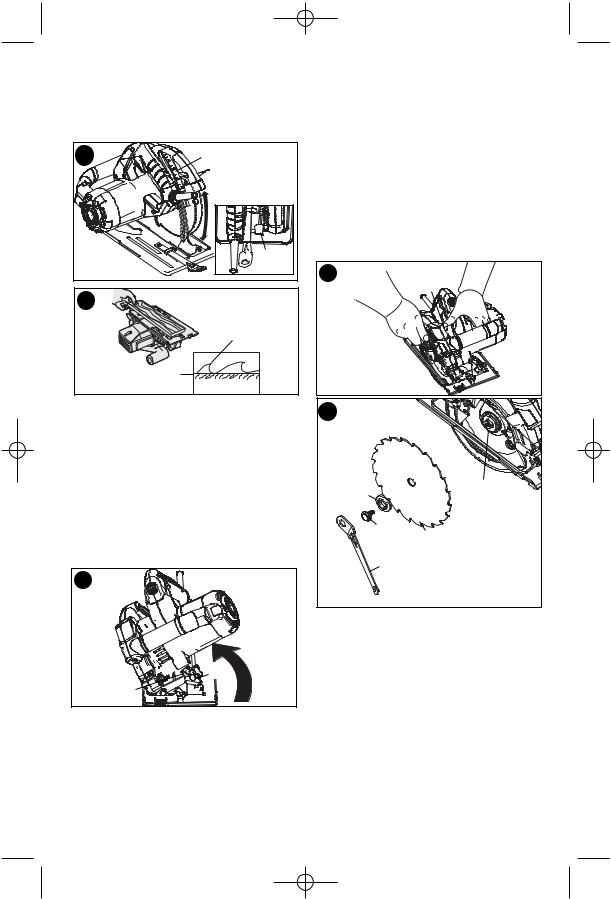
642743-00 CS1030 CS1040L 4/13/06 10:06 AM Page 8
•Tighten the lever to lock the saw shoe in place.
•Set depth adjustment of saw such that one tooth of the blade projects below the workpiece as shown in figure 8.
7 |
13 |
|
12 |
8 |
|
Tip of tooth
Surface of wood
ADJUSTING THE BEVEL ANGLE (FIG. 9)
This tool can be set to bevel angles between 0° and 45°.
•Loosen the locking knob (14) to unlock the saw shoe.
•Move the saw shoe (6) into the desired position. The corresponding bevel angle can be read from the scale (15).
•Tighten the locking knob to lock the saw shoe in place.
9





 14
14
15 



ATTACHING AND REMOVING THE BLADE
REMOVING THE BLADE (CS1040L) (FIG. 10 & 11)
•Keep the spindle lock button (5) depressed and rotate the blade until the spindle lock engages.
•Loosen and remove the blade retaining screw (16) by turning it counterclockwise using the wrench (10) supplied.
•Remove the outer washer (17).
•Remove the saw blade (7).
10
5
11 |
|
|
17 |
|
18 |
|
|
|
|
16 |
7 |
|
|
|
|
10 |
|
ATTACHING THE BLADE (CS1040L)
•Place the saw blade (7) onto the inner flange (18), making sure that the arrow on the blade points in the same direction as the arrow on the tool.
•Fit the outer washer (17) on the spindle, with the raised part pointing away from the saw blade.
•Insert the blade retaining screw (16) into the hole.
•Keep the spindle lock button (5) depressed.
•Securely tighten the blade retaining screw by turning it clockwise using the wrench (10) supplied.
8
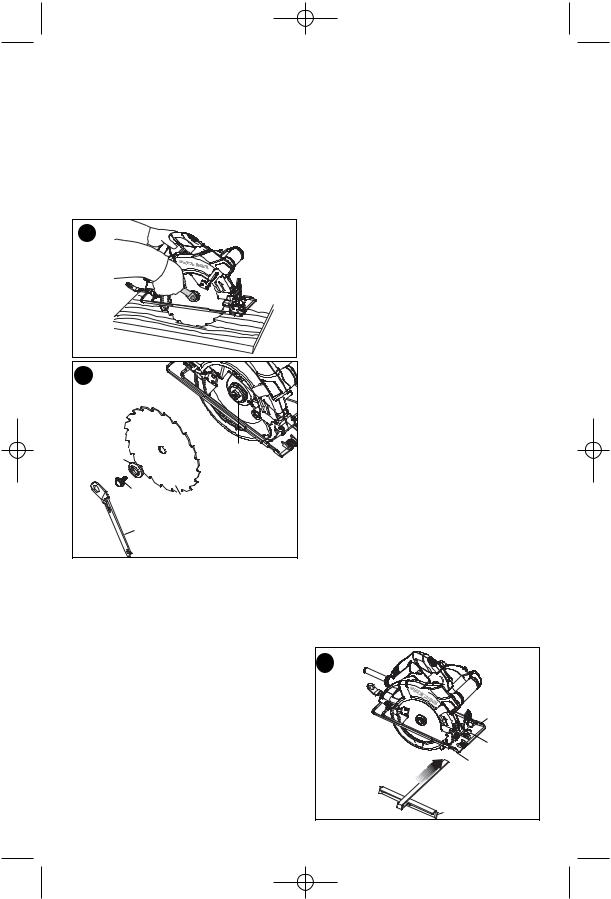
642743-00 CS1030 CS1040L 4/13/06 10:06 AM Page 9
REMOVING THE BLADE (CS1030L) (FIG. 12 & 13)
•Prevent spindle rotation by engaging the teeth of the saw blade into a piece of scrap wood.
•Loosen and remove the blade retaining screw (16) by turning it counterclockwise using the wrench (10) supplied.
•Remove the outer washer (17).
•Remove the saw blade (7).
12
GENERAL CUTS (IMPORTANT: READ SAFETY WARNINGS AND INSTRUCTIONS. )
GUARD AGAINST KICKBACK
With unit unplugged, follow all assembly, adjustment and set up instructions. Make sure lower guard operates. Select the proper blade for the material to be cut.
•Measure and mark work for cutting.
•Support and secure work properly (See Safety Rules and Instructions).
•Use appropriate and required safety equipment (See Safety Rules).
•Secure and maintain work area (See Safety Rules).
•With plug inserted and guard closed, make sure switch turns saw on and off.
 WARNING: It is important to support the work properly and to hold the saw firmly to prevent loss of control which could cause personal injury. Figure 3 illustrates recommended hand position.
WARNING: It is important to support the work properly and to hold the saw firmly to prevent loss of control which could cause personal injury. Figure 3 illustrates recommended hand position.
13 |
|
|
ATTACHING AND REMOVING THE RIP |
|
|
|
FENCE (INCLUDED WITH CS1040L) |
||
|
|
|
(FIG. 14) |
|
|
|
|
The rip fence is used to saw in a straight |
|
|
|
|
line parallel to the edge of the workpiece. |
|
17 |
|
18 |
ATTACHING |
|
|
|
Loosen the locking knob (19). |
||
|
|
|
Insert the rip fence (20) through the |
|
|
16 |
|
openings (21). |
|
|
7 |
Slide the rip fence into the desired |
||
|
|
|||
|
|
|
position. |
|
|
10 |
|
Tighten the locking knob. |
|
|
|
|
||
|
|
|
REMOVING |
|
ATTACHING THE BLADE (CS1030L) |
Loosen the locking knob. |
|||
Pull the rip fence out of the tool. |
||||
|
|
|
||
• Place the saw blade (7) onto the inner |
NOTE: If you do not have a proper fitting |
|
flange (18), making sure that the arrow |
fence, use a straight edge guide in contact |
|
on the blade points in the same |
the edge of the shoe to improve |
|
direction as the arrow on the tool. |
accuracy of cut and reduce the possibility |
|
• Fit the outer washer (17) on the |
binding and kickback. |
|
spindle, with the raised part pointing |
|
|
away from the saw blade. |
14 |
|
• Insert the blade retaining screw |
|
|
into the hole. |
|
|
• Prevent spindle rotation by engaging |
|
|
the teeth of the saw blade into a piece |
21 |
|
of scrap wood. |
||
|
||
• Securely tighten the blade retaining |
19 |
|
screw by turning it clockwise using the |
||
wrench (10) supplied. |
21 |
|
|
 WARNING: To reduce the risk of serious personal injury, read, understand
WARNING: To reduce the risk of serious personal injury, read, understand
and follow all important safety warnings 20 and instructions prior to using tool.
9
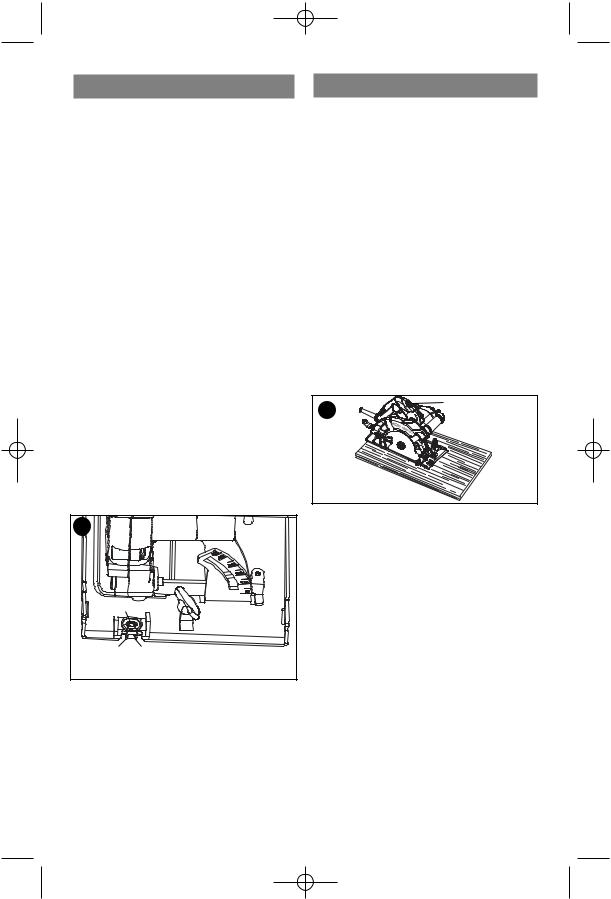
642743-00 CS1030 CS1040L 4/13/06 10:06 AM Page 10
OPERATION |
LASER LINE |
SWITCH
•To operate the tool, depress the trigger switch (1). The tool will continue to run as long as the trigger is depressed.
•To turn the tool off, release the trigger switch (1). There is no provision for locking the tool on, and the switch should never be locked on by any other means.
KERF PLATE ADJUSTMENT (FIG. 15)
The tool is equipped with a sight guide for straight cutting (22) and for 45° miter cutting (23).
•Be sure the saw is unplugged.
•Adjust the kerf plate as described below.
•Align the left edge of the guides (22) or (23) with the cutting line.
•Keep the kerf plate aligned with the cutting line while sawing.
•Work with the shoe pressed against the workpiece.
ADJUSTING THE KERF PLATE
•Plug in the saw.
•Make a test cut halfway through a piece of scrap wood.
•Withdraw the saw so the cutting line becomes visible.
•While keeping the saw in this position, unplug the saw and loosen the kerf plate on the saw shoe.
15 |
|
24 |
|
22 |
23 |
•Align the 0° mark (22) on the kerf plate with the cutting line. When adjusting for 45° miter cuts, align the 45° mark
(23)on the kerf plate with the cutting
line.
•Secure the kerf plate using the screw
 WARNING: LASER RADIATION. Never aim the beam at a workpiece with a reflective surface. Bright shiny reflective sheet steel or similar reflective surfaces are not recommended for laser use. Reflective surfaces could direct the beam back toward the operator.
WARNING: LASER RADIATION. Never aim the beam at a workpiece with a reflective surface. Bright shiny reflective sheet steel or similar reflective surfaces are not recommended for laser use. Reflective surfaces could direct the beam back toward the operator.
 DANGER: LASER RADIATION. AVOID DIRECT EYE EXPOSURE. Do not stare into the laser light source. Never aim light at another person or object other than the workpiece. Laser light can damage your eyes.
DANGER: LASER RADIATION. AVOID DIRECT EYE EXPOSURE. Do not stare into the laser light source. Never aim light at another person or object other than the workpiece. Laser light can damage your eyes.
 WARNING: DO NOT use tinted glasses to enhance the laser light.
WARNING: DO NOT use tinted glasses to enhance the laser light.
Tinted glasses will reduce overall vision for the application and interfere with the normal operation of the tool.
LASER SWITCH (FIG. 16)
To turn the laser on, push forward on the laser on/off switch (2) to activate the laser line (25) as shown in figure 16.
16 |
2 |
|
 25
25
TO USE THE LASER LINE
•Mark the line that you intend to cut on the workpiece.
•Adjust the depth and angle of cut as required.
•Push the laser on/off switch (2) to the forward “ON” position and project the laser beam.
•Depress the saw trigger switch (1) and allow the blade to reach maximum speed.
•Place the saw shoe on the workpiece. Align the laser line with the mark on the workpiece and slowly push the saw forward keeping the laser line on the mark.
•Upon completion of the cut, release the trigger and allow the saw blade to come to a complete stop before switching off the laser.
SAWING
 WARNING: To reduce the risk of serious personal injury,always hold the tool with both hands.
WARNING: To reduce the risk of serious personal injury,always hold the tool with both hands.
10
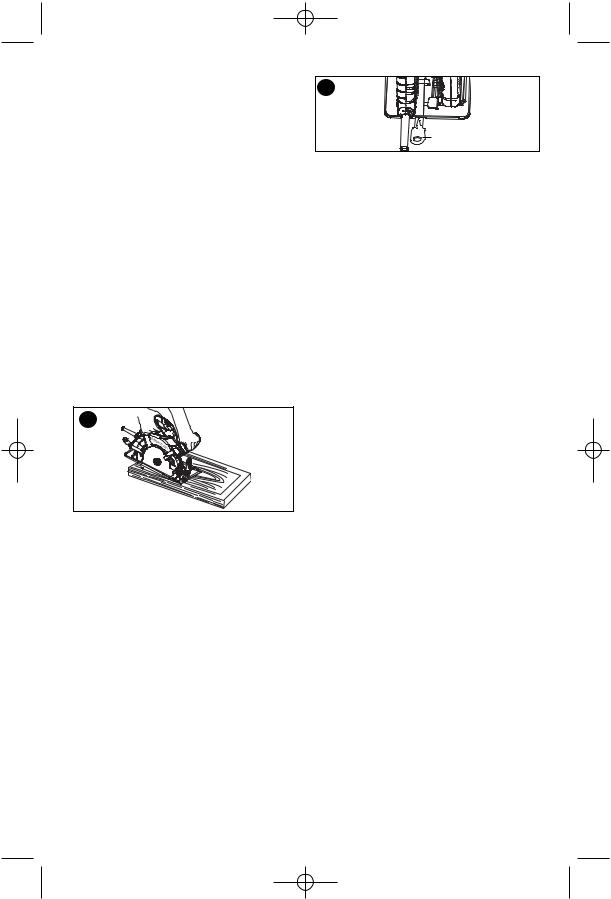
642743-00 CS1030 CS1040L 4/13/06 10:06 AM Page 11
•Let the blade run freely for a few seconds before starting the cut.
•Apply only a gentle pressure to the tool while performing the cut.
•Work with the shoe pressed against the workpiece.
HINTS FOR OPTIMUM USE
•As some splintering along the line of cut on the top side of the workpiece cannot be avoided, cut on the side where splintering is acceptable.
•Where splintering is to be minimized, e.g. when cutting laminates, clamp a piece of plywood onto the top of the workpiece.
POCKET CUTTING (FIG.17)
POCKET CUTTING IS USED TO CUTA HOLE IN APIECE OF MATERIAL WITHOUT CUTTING FROM THE SIDE.
•Measure and mark work.
•Tilt saw forward and rest front of the shoe on material to be cut. Align so that cut will begin at the back of the drawn rectangle shown in figure 17.
17
•Using the retracting lever, retract blade guard to an upward position, with the blade just clearing the material, start motor and gradually lower the saw into the material.
 WARNING: As blade starts cutting the material, release the retracting lever immediately.
WARNING: As blade starts cutting the material, release the retracting lever immediately.
•Never tie the blade guard in a raised position.
•When the shoe rests flat on the material being cut, complete the cut in forward direction.
•Allow the blade to come to a complete stop before lifting saw from material.
•When starting each new cut, repeat the above steps.
WRENCH STORAGE (FIG.18)
The blade wrench (10) can be stored on the saw shoe as shown in figure 18.
18
10
MAINTENANCE
Use only mild soap and damp cloth to clean the tool. Never let any liquid get inside the tool; never immerse any part of the tool into a liquid.
IMPORTANT: To assure product SAFETY and RELIABILITY, repairs, maintenance and adjustment (other than those listed in this manual) should be performed by authorized service centers or other qualified service organizations, always using identical replacement parts.
LUBRICATION
Black & Decker tools are properly lubricated at the factory and are ready for use.
ACCESSORIES
Recommended accessories for use with your tool are available from your local retailer.
 WARNING:The use of any accessory not recommended for use with this tool could be hazardous. Use only 7-1/4 “ (185mm) blades with 5/8” diameter arbor. Exception: 7" (175 mm) abrasive blades can be used.
WARNING:The use of any accessory not recommended for use with this tool could be hazardous. Use only 7-1/4 “ (185mm) blades with 5/8” diameter arbor. Exception: 7" (175 mm) abrasive blades can be used.
When cutting metal, be careful of hot sparks which are thrown by the blade.
SERVICE INFORMATION
All Black & Decker Service Centers are staffed with trained personnel to provide customers with efficient and reliable power tool service. Whether you need technical advice, repair, or genuine factory replacement parts, contact the Black & Decker location nearest you. To find your local service location, refer to the yellow page directory under "Tools— Electric" or call: 1-800-544-6986 or visit www.blackanddecker.com
FULL TWO-YEAR HOME USE WARRANTY
Black & Decker (U.S.) Inc. warrants this product for two years against any defects in material or workmanship. The defective product will be replaced or repaired at no charge in either of two ways.
The first, which will result in exchanges only, is to return the product to the retailer from whom it was purchased
11
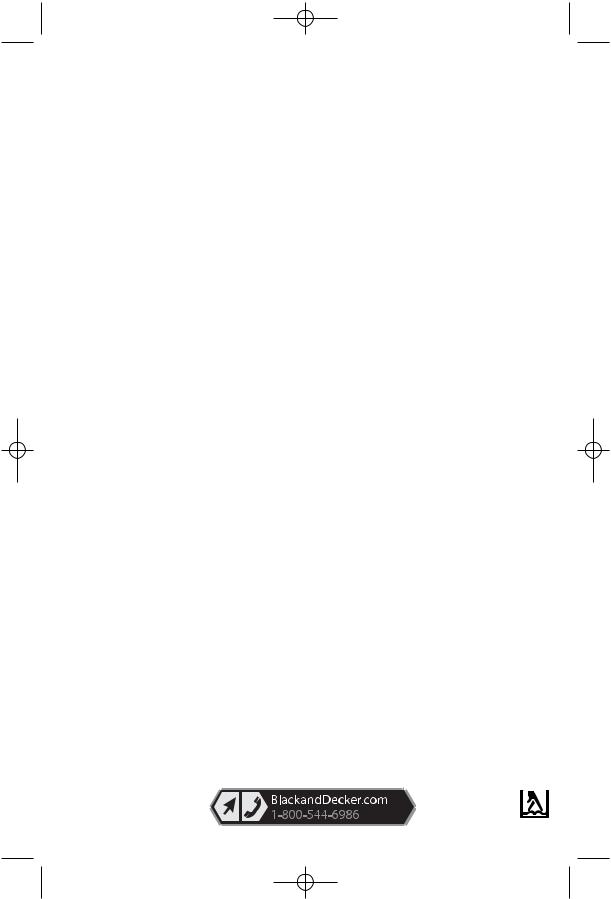
642743-00 CS1030 CS1040L 4/13/06 10:06 AM Page 12
(provided that the store is a participating retailer). Returns should be made within the time period of the retailer’s policy for exchanges (usually 30 to 90 days after the sale). Proof of purchase may be required. Please check with the retailer for their specific return policy regarding returns that are beyond the time set for exchanges.
The second option is to take or send the product (prepaid) to a Black & Decker owned or authorized Service Center for repair or replacement at our option. Proof of purchase may be required.Black & Decker owned and authorized Service Centers are listed under
"Tools-Electric" in the yellow pages of the phone directory.
This warranty does not apply to accessories. This warranty gives you specific legal rights and you may have other rights which vary from state to state or province to province. Should you have any questions, contact the manager of your nearest Black & Decker Service
Center. This product is not intended for commercial use.
Free Warning Label Replacement: If your warning labels become illegible or are missing, call 1-800-544-6986 for a free replacement.
TROUBLESHOOTING
Problem |
Possible Cause |
• Unit will not start. |
• Cord not plugged in. |
|
• Circuit fuse is blown. |
|
• Circuit breaker is tripped. |
|
• Cord or switch is damaged. |
Possible Solution
•Plug tool into a working outlet.
•Replace circuit fuse. (If the product repeatedly causes the circuit fuse to blow, discontinue use immediately and have it serviced at a Black & Decker service center or authorized servicer.)
•Reset circuit breaker. (If the product repeatedly causes the circuit breaker to trip, discontinue use immediately and have it serviced at a Black & Decker service center or authorized servicer.)
•Have cord or switch replaced at Black & Decker Service Center or Authorized Servicer
For assistance with your product, visit our website www.blackanddecker.com for the location of the service center nearest you or call the BLACK & DECKER help line at
1-800-544-6986.
TECHNICAL SPECIFICATIONS OF LASER:
Laser diode wavelength: |
633-670nm (red color) |
Laser Class: |
IIIa |
Operating temperature: |
41°F (5°C) - 104° F (40°C) |
Accuracy: |
+/- 1.8mm at every 300 mm |
Imported by |
See ‘Tools-Electric’ |
Black & Decker (U.S.) Inc., |
– Yellow Pages – |
701 E. Joppa Rd. |
for Service & Sales |
Towson, MD 21286 U.S.A. |
|
12
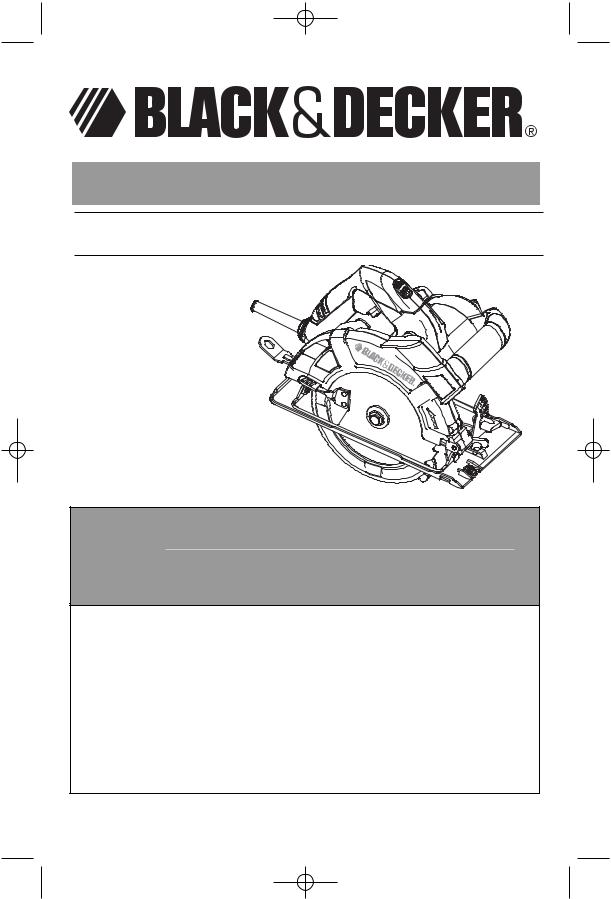
642743-00 CS1030 CS1040L 4/13/06 10:06 AM Page 13
Scies circulaires 7-1/4” (185 mm)
GUIDE D’UTILISATION
Numéros de catalogue
CS1030L / CS1040L
MERCI D’AVOIR CHOISI BLACK & DECKER !
VISITEZ WWW.BLACKANDDECKER.COM/NEWOWNER
POUR ENREGISTRER VOTRE NOUVEAU PRODUIT.
AVANT DE RETOURNER CE PRODUIT POUR QUELQUE RAISON QUE CE SOIT, COMPOSER LE
1-800-544-6986
AVANT D’APPELER,AYEZ EN MAIN LE N° DE CATALOGUE ET LE CODE DE DATE. DANS LAPLUPART DES CAS, UN REPRÉSENTANT DE BLACK & DECKER PEUT RÉSOUDRE LE PROBLÈME PAR TÉLÉPHONE. SI VOUSAVEZ UNE SUGGESTION OU UN COMMENTAIRE,APPELEZ-NOUS. VOS IMPRESSIONS SONT CRUCIALES POUR BLACK & DECKER.
CONSERVER CE MANUEL POUR UN USAGE ULTÉRIEUR.
13
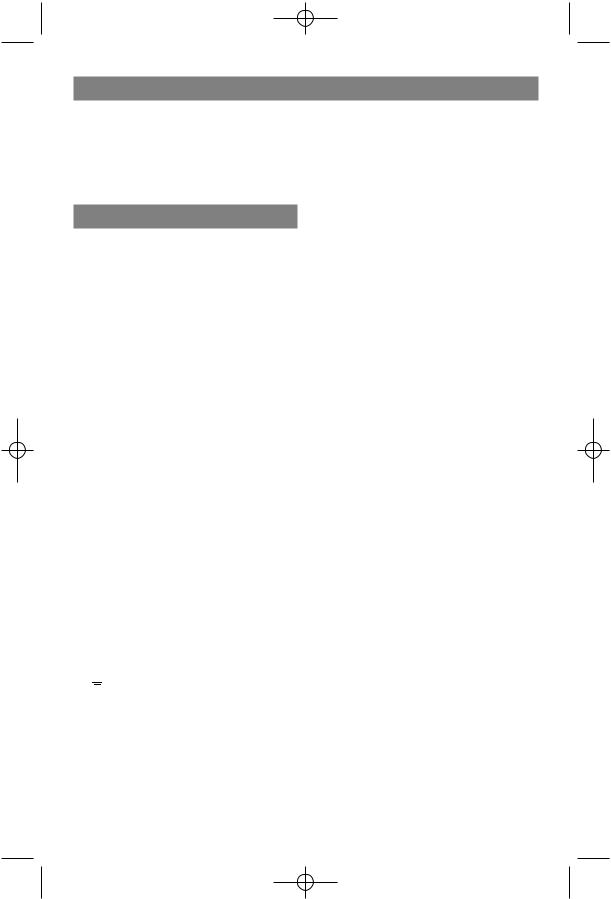
642743-00 CS1030 CS1040L 4/13/06 10:06 AM Page 14
RÈGLES GÉNÉRALES DE SÉCURITÉ
 AVERTISSEMENT : Assurez-vous de lire et de comprendre toutes les directives. Négliger de suivre les instructions énumérées ci-dessous pourrait être la cause d'un choc électrique, d'un incendie ou d'une blessure corporelle grave.s
AVERTISSEMENT : Assurez-vous de lire et de comprendre toutes les directives. Négliger de suivre les instructions énumérées ci-dessous pourrait être la cause d'un choc électrique, d'un incendie ou d'une blessure corporelle grave.s
CONSERVEZ CES DIRECTIVES aVE THESTRUCTIONS
ZONE DE TRAVAIL
•Assurez-vous que votre espace de travail est propre et bien éclairé. Les bancs encombrés et les endroits sombres sont souvent des causes d’accidents.
•Ne faites pas fonctionner d’outils électriques dans une atmosphère inflammable, soit en présence de liquides inflammables, de gaz ou de poussière. Les outils électriques produisent des étincelles qui peuvent enflammer la poussière ou les vapeurs.
•Éloignez les curieux, les enfants et les visiteurs lorsque vous utilisez un outil électrique. Une distraction pourrait vous en faire perdre la maîtrise.
SÉCURITÉ EN ÉLECTRICITÉ
•Les outils à double isolation sont dotés d’une fiche polarisée (dont une lame de contact est plus large que l’autre). Cette fiche ne se branche que d’une seule façon dans une prise de courant polarisée.
Si la fiche ne s’insère pas totalement dans la prise de courant, renversez-la. Si elle ne s’insère toujours pas dans la prise, demandez à un électricien compétent d’installer une fiche polarisée. Ne tentez pas de
remplacer la fiche. La double isolation
 élimine la nécessité d’utiliser un cordon d’alimentation muni d’une fiche à trois fils avec mise à la terre et un bloc d’alimentation avec mise à la terre.
élimine la nécessité d’utiliser un cordon d’alimentation muni d’une fiche à trois fils avec mise à la terre et un bloc d’alimentation avec mise à la terre.
•Évitez tout contact physique avec des surfaces mises à la terre tels des tuyaux, des radiateurs, des cuisinières et des réfrigérateurs. Le risque d’électrocution est plus élevé
lorsque votre corps est mis à la terre.
•Ne laissez pas vos outils électriques sous la pluie ou dans un environnement humide. Une infiltration d’eau dans un outil électrique augmente le risque d’électrocution.
•Faites attention au cordon électrique. Ne l’utilisez pas pour transporter l’outil. Ne tirez jamais sur le cordon pour le débrancher de la prise de courant. Éloignez le cordon électrique de la chaleur, de l’huile, des bords tranchants ou des pièces mobiles. Remplacez immédiatement tout cordon électrique endommagé. Un cordon endommagé peut provoquer une électrocution.
•Lorsqu’on utilise un outil électrique à l’extérieur, on ne doit utiliser que des rallonges conçues pour cet usage, comme celles de type « W-A » ou « W », afin de réduire les risques de choc électrique.
|
Calibre minimum pour les rallonges |
|||
Volts |
Longueur totale du cordon en pieds |
|||
120V |
0-25 |
26-50 |
51-100 |
101-150 |
240V |
0-50 |
51-100 |
101-200 |
201-300 |
Intensité nominale
Plus Pas plus Calibre moyen de fil (AWG)
que |
que |
|
|
|
|
0 - |
6 |
18 |
16 |
16 |
14 |
6 - |
10 |
18 |
16 |
14 |
12 |
10- |
12 |
16 |
16 |
14 |
12 |
12- |
16 |
14 |
12 |
Non recommandé |
|
SÉCURITÉ PERSONNELLE
•Soyez vigilant, faites attention à ce que vous faites et faites preuve de jugement lorsque vous utilisez un outil électrique. N’utilisez pas un outil lorsque vous êtes fatigué ou lorsque vous avez pris de la drogue, de l’alcool ou des médicaments. Un moment d’inattention, lorsque vous utilisez un outil électrique, peut se solder par des blessures sérieuses.
•Habillez-vous en conséquence. Ne portez pas de vêtements amples ni de bijoux qui pourraient s'enchevêtrer quelque part. Attachez les cheveux longs. Gardez les cheveux, les vêtements et les gants à l'écart des pièces mobiles. Les vêtements amples, bijoux ou cheveux longs pourraient s'enchevêtrer dans les
14
